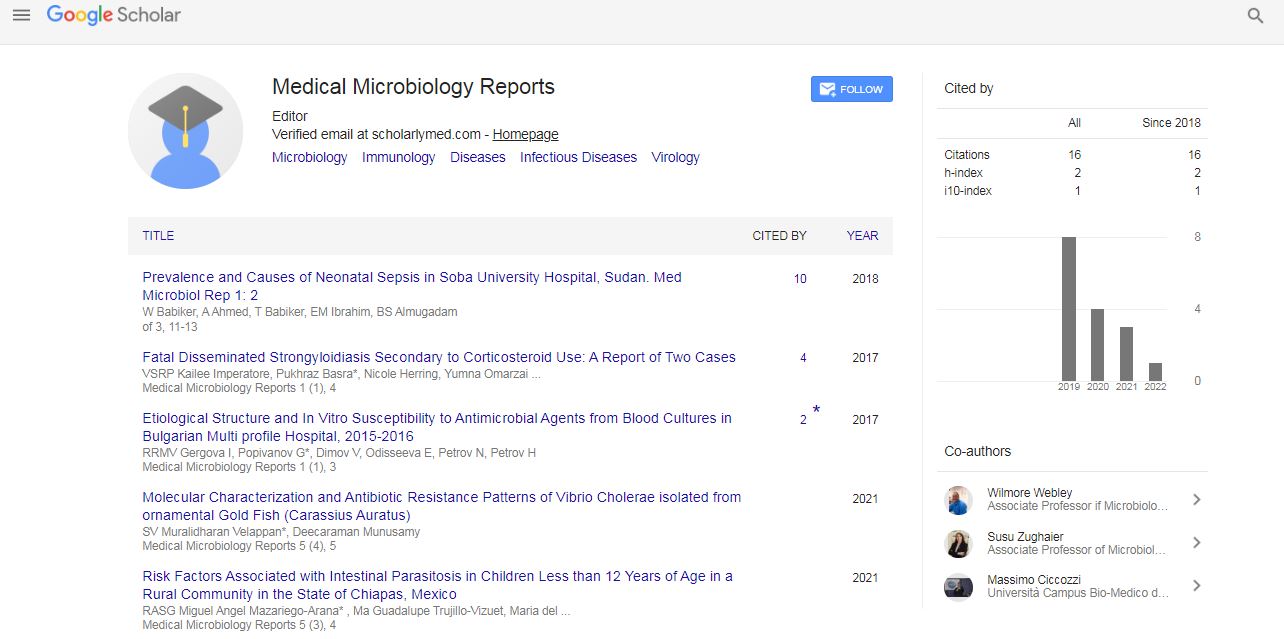Opinion Article, Med Microbiol Rep Vol: 7 Issue: 2
Analyzing the Effects of Pathogenic Fungi
Shifei Kassyo*
Department of Plant Pathology, Kasetsart University, Bangkok, Thailand
*Corresponding Author: Shifei Kassyo
Department of Plant Pathology, Kasetsart University, Bangkok, Thailand
E-mail: shikassy@ku.ac.th
Received date: 22 May, 2023, Manuscript No. MMR-23-107435;
Editor assigned date: 25 May, 2023, PreQC No. MMR-23-107435 (PQ);
Reviewed date: 08 June, 2023, QC No. MMR-23-107435;
Revised date: 15 June, 2023, Manuscript No. MMR-23-107435 (R);
Published date: 22 June, 2023, DOI: 10.4172/mmr.1000336
Citation: Kassyo S (2023) Analyzing the Effects of Pathogenic Fungi. Med Microbiol Rep 7:2
Description
Pathogenic fungi are a diverse group of microorganisms that can cause a range of infections and diseases in humans. These fungi possess unique characteristics and mechanisms that allow them to invade host tissues, evade immune defenses and induce harmful effects. Analyzing the effects of pathogenic fungi is important for understanding the spectrum of diseases they cause and developing effective strategies for diagnosis, treatment and prevention.
Pathogenic fungi can cause a variety of infections, classified based on the site of infection and the degree of tissue involvement. Superficial fungal infections primarily affect the skin, hair and nails, resulting in conditions such as athlete's foot, ringworm and fungal nail infections. Subcutaneous fungal infections penetrate deeper layers of the skin and underlying tissues, leading to chronic infections that are often difficult to treat.
The effects of pathogenic fungi on human health can vary, depending on the type of infection, the site of infection and the immune status of the individual. Fungal infections can range from mild and localized to severe and life-threatening. Superficial fungal infections generally cause discomfort, itching and cosmetic issues. However, systemic fungal infections can lead to organ failure, sepsis and even death, particularly in individuals with weakened immune systems, such as those with Human Immunodeficiency Virus Infection/Acquired Immune Deficiency Syndrome (HIV/AIDS) or undergoing immunosuppressive therapy.
One significant effect of pathogenic fungi is tissue damage. Fungi can invade and colonize host tissues, leading to inflammation, necrosis and destruction of cells and structures. The presence of fungi triggers an immune response, characterized by the release of inflammatory mediators and the recruitment of immune cells. While this response aims to eliminate the fungal infection, it can also contribute to tissue damage and pathology.
Another effect of pathogenic fungi is the production of virulence factors that aid in their survival and invasion. For instance, some fungi secrete enzymes, such as proteases and lipases, which help them break down host tissues and obtain nutrients. Fungal toxins, such as aflatoxins produced by Aspergillus species, can have detrimental effects on human health, including liver damage and an increased risk of cancer.
The immune response plays a vital role in determining the outcome of fungal infections. In individuals with intact immune systems, the immune response can effectively control and eliminate fungal pathogens. However, in immunocompromised individuals, such as those with HIV/AIDS, organ transplant recipients or patients undergoing chemotherapy, the immune response is compromised, allowing fungal infections to persist and spread. These infections can become chronic and difficult to treat, requiring extensive medical interventions.
In recent years, molecular techniques have revolutionized the analysis of pathogenic fungi. Polymerase Chain Reaction (PCR) assays can detect fungal DNA or specific genetic targets, providing rapid and sensitive identification of fungal pathogens. Next- Generation Sequencing (NGS) technologies allow for comprehensive genomic analysis of fungal isolates, enabling analysts to analyze genetic diversity, virulence factors and mechanisms of antifungal resistance.
The treatment of fungal infections often relies on antifungal drugs, which can be administered topically, orally or intravenously depending on the type and severity of the infection. However, the emergence of drug-resistant fungal strains poses a significant challenge. Analyzing the mechanisms of antifungal resistance and monitoring the prevalence of resistant strains are essential for guiding treatment decisions and developing new therapeutic approaches.
Prevention and control strategies for fungal infections involve a combination of public health measures and individual precautions. These include maintaining good personal hygiene, avoiding contact with contaminated materials, practicing safe intimacy, implementing infection control measures in healthcare settings and addressing underlying conditions that predispose individuals to fungal infections, such as immunodeficiency or diabetes.
Conclusion
Analyzing the effects of pathogenic fungi is essential for understanding the spectrum of diseases they cause and developing effective strategies for their diagnosis, treatment and prevention. The impact of these fungi on human health can range from mild to lifethreatening, particularly in individuals with weakened immune systems. Advancements in diagnostic techniques and a comprehensive understanding of fungal pathogenesis are important for improving patient outcomes and controlling the spread of fungal infections.
 Spanish
Spanish  Chinese
Chinese  Russian
Russian  German
German  French
French  Japanese
Japanese  Portuguese
Portuguese  Hindi
Hindi 
